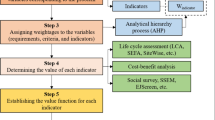Abstract
Five wooden trackways in raised bogs located along a precipitation gradient in Northwest Europe (Ireland, England, The Netherlands and Germany), and all dated toc. 2600 cal.BC, show differences in building method related to variable hydrological conditions in the local bog surfaces. Differences in the bearing strength of the highly humified hummock-hollow surfaces can be largely attributed to differences in the climatically related water content of the peat. Water balance studies, based on current climatic data and using the concept of system-linked discharge, can explain the hydrological differences between the ombrotrophic bogs established by archaeological excavations of the wooden trackways. Active peat growth at the time of construction and building methods used indicate mean annual precipitation values similar to present reflecting the modern rainfall gradient.
Similar content being viewed by others
References
Burke, W., 1975. Effect of drainage on the hydrology of blanket bog. Kinsealy Research Centre, Dublin.
Casparie, W. A., 1982. The Neolithic wooden trackway XXI (Bou) in the raised bog at Nieuw-Dordrecht (The Netherlands). Palaeohistoria 24: 115–164.
Casparie, W. A., 1987. Bog trackways in the Netherlands. Palaeohistoria 29: 35–65.
Casparie, W. A. & A. Moloney, 1992. Niederschlagsklima und Bautechnik neolithischer hölzerner Moorwege. Moorarchäologie in Nordwest-Europa. Gedenkschrift für Dr h.c. Hajo Hayen (=Archäologische Mitteilungen aus Nordwestdeutschland) 15: 69–88.
Casparie, W. A. & J. G. Streefkerk, 1992. Climatological, stratigraphic and palaeo-ecological aspects of mire development. In J. T. A. Verhoeven (ed.), Fens and Bogs in the Netherlands: Vegetation, History, Nutrient Dynamics and Conservation. Kluwer Academic Press, Dordrecht: 81–129.
Coles, J. M., 1980. The Abbot's Way 1979. Somerset Levels Papers 6: 46–49.
Coles, B. J. & M. J. Dobson, 1989. Calibration of radiocarbon dates from the Somerset Levels. Somerset Levels Papers 15: 64–72.
Coles, J. M. & B. J. Orme, 1976. The Abbot's Way. Somerset Levels Papers 2: 7–20.
Eggelsmann, R., 1960. Über die unterirdischen Abfluss aus Mooren. Wasserwirtschaft 50: 149–154.
Eggelsmann, R., 1980. Moorhydrologie. In K. Göttlich (ed.), Moorund Torfkunde. Schweitzerbart, Stuttgart, 2nd ed.: 210–224.
Eggelsmann, R. & E. Klose, 1982. Regenerationsversuch auf industriell abgetorftem Hochmoor im Lichtenmoor — erste hydrologische Ergebnisse. Telma 17: 51–58.
Hayen, H., 1984. Moorarchäologie in Niedersachsen. Berichte zur Denkmalpflege in Niedersachsen 4: 132–135.
Hayen, H., 1985. Bergung, wissenschaftliche Untersuchung und Konservierung moorarchäologischer Funde. Vorbericht zu einem Forschungsunternehmen. Archäologische Mitteilungen aus Nordwestdeutschland 8: 1–43.
Hayen, H., 1989. Bau und Funktion der hölzernen Moorwege: Einige Fakten und Folgerungen. Untersuchungen zu Handel und Verkehr der vor- und frühgeschichtlichen Zeit in Mittel- und Nordeuropa 5: 11–82.
Kuntze, H., 1990. Zur Integration der Moore in die Kulturlandschaft. Moore und Torfe. Niedersächsische Akademie der Geowissenschaften, Veröffentlichungen 5: 74–84.
Moloney, A., D. Jennings, M. Keane & C. McDermott, 1993. Survey of the raised bogs of County Longford. Irish Archaeological Wetland Unit, Transactions 1, 120 pp.
Overbeck, F., 1975. Botanisch-geologische Moorkunde. Karl Wachholtz, Neumünster.
Raftery, B., 1990. Trackways through Time. Archaeological Investigations on Irish Bog Trackways. Headline Publishing, Rush, Co. Dublin, 75 pp.
Romanov, V. V., 1968. Hydrophysics of bogs. Israel Program for Scientific Translations, Jeruzalem.
Streefkerk, J. G. & W. A. Caspaire, 1989. The hydrology of bog ecosystems. Staatsbosbeheer report, Utrecht, 119 pp.
Streefkerk, J. G. & P. J. Oosterlee, 1984. Een beschouwing over hydrologische ingrepen in het hoogveenreservaat Bargerveen. Staatsbosbeheer report, Utrecht, 67 pp.
Author information
Authors and Affiliations
Additional information
This publication is the fourth paper in a series of papers presented at the session on ‘Past Climatic Change and the Development of Peatlands’ at the ASLO and SWS Meetings in Edmonton, Canada, May 30–June 3, 1993. Dr P. Kuhry and Dr S. C. Zoltai are serving as Guest Editors.
Rights and permissions
About this article
Cite this article
Casparie, W.A., Moloney, A. Neolithic wooden trackways and bog hydrology. J Paleolimnol 12, 49–64 (1994). https://doi.org/10.1007/BF00677989
Received:
Accepted:
Issue Date:
DOI: https://doi.org/10.1007/BF00677989




